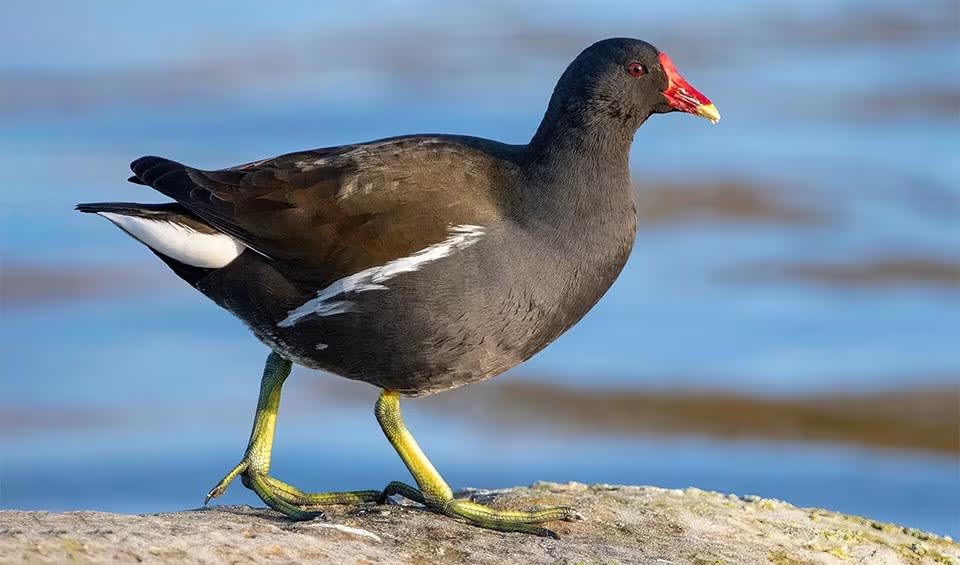The common moorhen, also known as the waterhen or swamp chicken, is a fascinating bird species found in wetland habitats across much of the world. Known for its distinctive appearance and behavior, the common moorhen is a frequent sight in brackish marshes, ponds, lakeshores, and other freshwater and mixed vegetation areas.
These birds are superbly adapted to their aquatic lifestyle, with their sleek bodies, long legs, and partially webbed feet enabling them to navigate through shallow water with ease. Common moorhens are skilled swimmers, propelling themselves with powerful kicks of their legs while using their wings for balance and stability. They are also adept at diving and can spend considerable time underwater in search of food.
Speaking of food, common moorhens are omnivorous and have a varied diet that includes both plant matter and small aquatic animals. They feed on a wide range of vegetation, such as leaves, seeds, and roots, as well as insects, small fish, crustaceans, and mollusks that they glean from the water’s surface or capture with their sharp beaks.
During the breeding season, which typically occurs from spring to summer, common moorhens engage in elaborate courtship rituals. Females play an active role in courtship, displaying to attract males with a series of behaviors that may include vocalizations, wing-flapping, and swimming displays. Once a pair bond is formed, the birds work together to build a nest, usually constructed at the water’s edge among dense vegetation. The nest is a sturdy structure made from twigs, leaves, and other plant material, providing a secure environment for the eggs and chicks.
Female common moorhens typically lay clutches of 8-10 eggs, which are incubated by both parents for around three weeks until they hatch. After hatching, both parents are involved in caring for the chicks, providing them with food and protection until they are old enough to fend for themselves. Interestingly, common moorhens may engage in cooperative breeding, with other members of the group assisting in raising the chicks.
Distribution
 Afghanistan
Afghanistan Albania
Albania Algeria
Algeria Angola
Angola Armenia
Armenia Austria
Austria Azerbaijan
Azerbaijan Bahrain
Bahrain Bangladesh
Bangladesh Belarus
Belarus Belgium
Belgium Benin
Benin Bosnia And Herz.
Bosnia And Herz. Botswana
Botswana Brunei
Brunei Bulgaria
Bulgaria Burkina Faso
Burkina Faso Burundi
Burundi Cambodia
Cambodia Cameroon
Cameroon Cape Verde
Cape Verde Central Af. Rep.
Central Af. Rep. Chad
Chad China
China Comoros
Comoros Congo-Brazzaville
Congo-Brazzaville Croatia
Croatia Cyprus
Cyprus Czechia
Czechia Côte D’ivoire
Côte D’ivoire DR Congo (Kinshasa)
DR Congo (Kinshasa) Denmark
Denmark Djibouti
Djibouti Egypt
Egypt Equatorial Guinea
Equatorial Guinea Official estimate
Official estimate
 Eritrea
Eritrea Estonia
Estonia Eswatini
Eswatini Ethiopia
Ethiopia Faroe Islands
Faroe Islands Finland
Finland France
France Gambia
Gambia Georgia
Georgia Germany
Germany Ghana
Ghana Gibraltar
Gibraltar Greece
Greece Greenland
Greenland Guam
Guam Guinea-Bissau
Guinea-Bissau Guinea
Guinea Hong Kong
Hong Kong Hungary
Hungary Iceland
Iceland India
India Indonesia
Indonesia Iran
Iran Iraq
Iraq Ireland
Ireland Israel
Israel Italy
Italy Japan
Japan Jordan
Jordan Kazakhstan
Kazakhstan Kenya
Kenya Korea
Korea Kuwait
Kuwait Kyrgyzstan
Kyrgyzstan Laos
Laos Latvia
Latvia Lebanon
Lebanon Lesotho
Lesotho Liberia
Liberia Libya
Libya Liechtenstein
Liechtenstein Lithuania
Lithuania Luxembourg
Luxembourg Macao
Macao Madagascar
Madagascar Malawi
Malawi Malaysia
Malaysia Maldives
Maldives Mali
Mali Malta
Malta Mauritania
Mauritania Mauritius
Mauritius Mayotte
Mayotte Micronesia
Micronesia Moldova
Moldova Mongolia
Mongolia Montenegro
Montenegro Morocco
Morocco Mozambique
Mozambique Myanmar
Myanmar Namibia
Namibia Nepal
Nepal Netherlands
Netherlands Niger
Niger Nigeria
Nigeria Nort. Mariana Is.
Nort. Mariana Is. North Korea
North Korea North Macedonia
North Macedonia Norway
Norway Oman
Oman Pakistan
Pakistan Palau
Palau Philippines
Philippines Poland
Poland Portugal
Portugal Qatar
Qatar Romania
Romania Russia
Russia Rwanda
Rwanda Réunion
Réunion Saint Helena
Saint Helena Saudi Arabia
Saudi Arabia Senegal
Senegal Serbia
Serbia Seychelles
Seychelles Sierra Leone
Sierra Leone Singapore
Singapore Slovakia
Slovakia Slovenia
Slovenia Somalia
Somalia South Africa
South Africa Spain
Spain Sri Lanka
Sri Lanka Sudan
Sudan Svalbard
Svalbard Sweden
Sweden Switzerland
Switzerland Syria
Syria São Tomé & Príncipe
São Tomé & Príncipe Taiwan
Taiwan Tajikistan
Tajikistan Tanzania
Tanzania Thailand
Thailand Togo
Togo Tunisia
Tunisia Turkey
Turkey Turkmenistan
Turkmenistan UAE
UAE Uganda
Uganda Ukraine
Ukraine United Kingdom
United Kingdom Uzbekistan
Uzbekistan Vietnam
Vietnam Yemen
Yemen Zambia
Zambia Zimbabwe
ZimbabweAnything we've missed?
Help us improve this page by suggesting edits. Glory never dies!
Suggest an editGet to know me
Terrestrial / Aquatic
Altricial / Precocial
Polygamous / Monogamous
Dimorphic (size) / Monomorphic
Active: Diurnal / Nocturnal
Social behavior: Solitary / Pack / Herd
Diet: Carnivore / Herbivore / Omnivore / Piscivorous / Insectivore
Migratory: Yes / No
Domesticated: Yes / No
Dangerous: Yes / No




